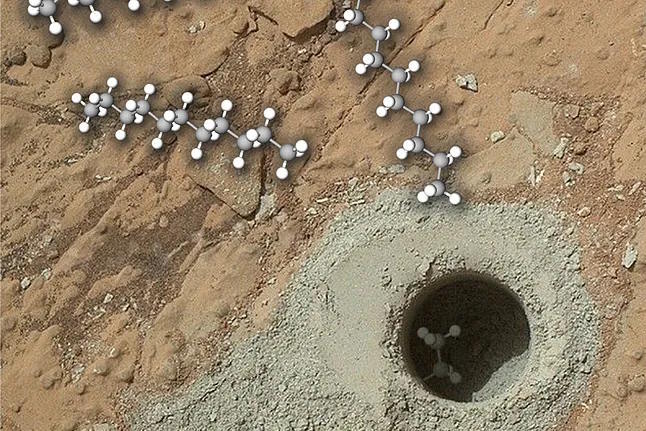While life thrives on Earth, NASA's robotic vehicles Curiosity and Perseverance continue to tirelessly explore Mars year after year, making astonishing discoveries thanks to the instruments they carry to analyze samples in situ. The latest, very exciting, was announced this Monday and constitutes great news for the search for traces of ancient life on a harsh planet that, however, long ago resembled ours.
Curiosity, which arrived at the Gale crater in 2012, has discovered in clay-rich terrain the most complex and ancient molecules found on Mars to date: organic molecules of hydrogen and carbon of unprecedented size, containing up to 12 consecutive carbon atoms - until now, organic molecules found on the red planet had at most six carbon atoms. Additionally, they were formed a staggering 3.7 billion years ago.
"It is the first time that molecules like these have been identified on Mars, so complex and so ancient," summarizes Felipe Gómez Gómez, the researcher from the Center of Astrobiology (CAB/CSIC-INTA) who is part of the study that analyzed Curiosity's discovery, and whose conclusions are published this Monday in the journal Proceedings of the National Academy of Sciences (PNAS). "Molecules as long and mature as these have never been found, which could come from even longer chain fatty acids. Fatty acids on Earth are related to life. However, we do not know the origin of those identified on Mars, and we cannot confirm if they are abiotic or biotic," he admits.
In other words, scientists cannot yet determine how they were formed, whether it was due to the activity of some organism (biotic), or if they are abiotic molecules, meaning their formation did not involve a living being. Because although these fatty acids are a component of terrestrial cells, they also form through abiotic processes.
As the Spanish scientist points out, their origin is an enigma, but these types of molecules are present on our planet: "We know them very well, we know what they are because here on Earth there are many examples," he states.
Regardless of their origin, the discovery demonstrates that the Martian soil may still contain bio-signatures from a very ancient geological period, meaning it may have preserved chemical elements that undoubtedly reveal there was life.
The lack of geological activity and the cold, arid climate of Mars have contributed to preserving this valuable organic matter in a clay-rich sample over the last 3.7 billion years. Therefore, these organic molecules date back to the time when life was emerging on Earth.
"The discovery is very interesting due to the length of the molecules and the location where they have been identified, as the rock is a mudstone, that is, a rock formed by the deposition of precipitates and mud in a liquid medium that later compacts and dries into rock," details the researcher.
Curiosity made this discovery with its SAM instrument, co-financed by the French Space Agency (CNES), and in its analysis, led by the French researcher Caroline Freissinet, scientists from France, the USA, Spain, and Mexico have participated.
The Spanish contribution from the Center of Astrobiology to this international research, according to Gómez, has involved collaborating in the analysis of the SAM instrument and conducting similar experiments in the laboratories of this center located in Madrid: "Additionally, we traveled to the Tinto River [in the province of Huelva] to refine the protocols for identifying this type of molecules in extreme environments."
According to Gómez, this discovery will "help us understand the preservation capacity of molecules of this type on the red planet." And discovering traces of life will be the goal of future Martian rovers that will explore the red planet, such as those from the European ExoMars mission, whose launch is scheduled for 2028 if no new setbacks arise, and Mars Sample Return, which will be jointly carried out by NASA and ESA in the early 2030s.
Likewise, the future drone Dragonfly, which will explore Titan, the largest moon of Saturn, in the 2030s, will carry an instrument similar to SAM.
